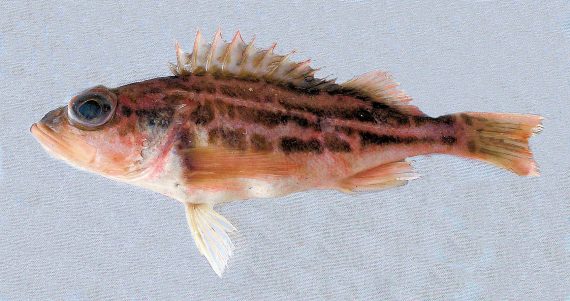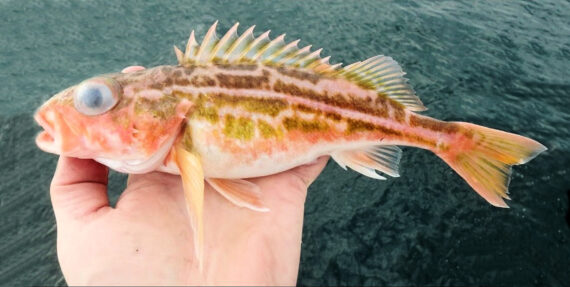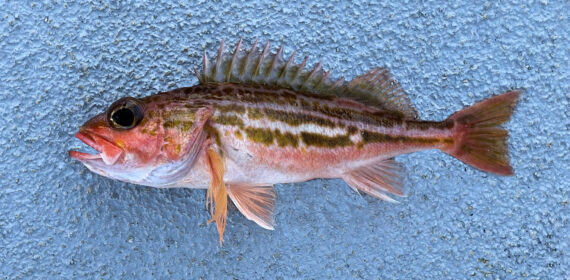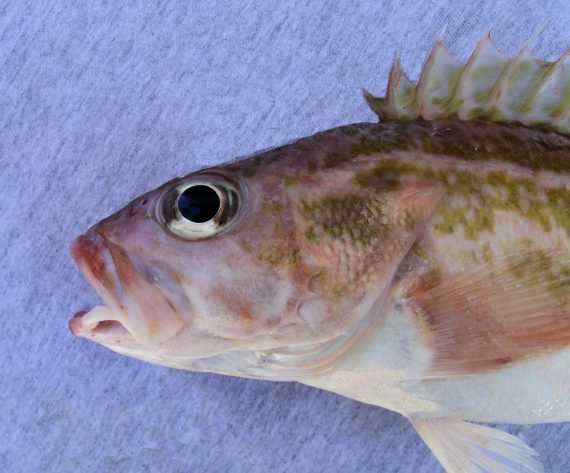Greenstriped Rockfish, Sebastes elongatus
 Greenstriped Rockfish, Sebastes elongatus, Juvenile. Fish provided by the commercial fishermen of the greater San Diego area, San Diego, California, October 2014. Length: 20 cm (7.9 inches).
Greenstriped Rockfish, Sebastes elongatus, Juvenile. Fish provided by the commercial fishermen of the greater San Diego area, San Diego, California, October 2014. Length: 20 cm (7.9 inches).
 Greenstriped Rockfish, Sebastes elongatus. Fish caught from coastal waters off San Diego, California, December 2020. Length: 21 cm (8.3 inches). Catch, photograph, and identification courtesy of Josh Leisen (joshadventures.com), Gaylord, Michigan.
Greenstriped Rockfish, Sebastes elongatus. Fish caught from coastal waters off San Diego, California, December 2020. Length: 21 cm (8.3 inches). Catch, photograph, and identification courtesy of Josh Leisen (joshadventures.com), Gaylord, Michigan.
 Greenstriped Rockfish, Sebastes elongatus. Fish caught from coastal waters off Tijuana, Baja California, February, 2023. Length: 28 cm (11 inches). Catch, identification and photograph courtesy of Luke Ovgard, Klamath Falls, Oregon.
Greenstriped Rockfish, Sebastes elongatus. Fish caught from coastal waters off Tijuana, Baja California, February, 2023. Length: 28 cm (11 inches). Catch, identification and photograph courtesy of Luke Ovgard, Klamath Falls, Oregon.
 Greenstriped Rockfish, Sebastes elongatus. Fish caught from coastal waters off Tijuana, Baja California, February 2023. Length: 30 cm (12 inches). Catch, photograph, and identification courtesy of Chris Moore, Peoria, Arizona.
Greenstriped Rockfish, Sebastes elongatus. Fish caught from coastal waters off Tijuana, Baja California, February 2023. Length: 30 cm (12 inches). Catch, photograph, and identification courtesy of Chris Moore, Peoria, Arizona.

 Greenstriped Rockfish, Sebastes elongatus. Fish provided by the commercial fishermen of the greater San Diego area, San Diego, California, October 2014. Length: 32 cm (13 inches).
Greenstriped Rockfish, Sebastes elongatus. Fish provided by the commercial fishermen of the greater San Diego area, San Diego, California, October 2014. Length: 32 cm (13 inches).
The Greenstriped Rockfish, Sebastes elongatus, is a member of the Rockfish and Scorpionfish or Scorpaenidae Family, and is known in Mexico as rocote reina. Globally, there are one hundred eight species in the genus Sebastes, of which fifty-three are found in Mexican waters, all in the Pacific Ocean.
The Greenstriped Rockfish has an elongated narrow body with a depth that is 30% to 34% of standard length. They have an overall pale reddish coloration and feature four horizontal stripes. A small percentage of the population is melanistic with black blotches on their sides. Their anal and pelvic fins are transparent; their caudal and dorsal fins are dusky; and, their pectoral fin are dark red. Their head is modest in size and features medium-sized eyes. Their mouth is small and ends well before the eyes. They have small venom-secreting glands in their anal, dorsal, and pelvic spines. Their anal fin has 3 spines (the second and third being stout and the third being longer than the second) and 5 to 7 rays; their caudal fin is square to slightly lunate; their dorsal fin has 13 spines and 10 to 14 rays; and their pectoral fins have 16 to 18 rays. They have 28 to 33 gill rakers and their body is covered with scales.
The Greenstriped Rockfish reside in a wide variety of habitats including over cobblestone, rubble, and muddy bottoms at depths between 12 m (40 feet) and 192 m (1,630 feet). They reach a maximum length of 49 cm (19 inches), with females being larger than males. As of January 1, 2024, the International Game Fish Association world record stood at 0.63 kg (1 lb 6 oz) with the fish caught in coastal waters off San Clemente Island, California in March 2000. They are bottom dwellers with more mature fish found in deeper waters. They are either solitary individuals or found within schools of other rockfish. They feed on bottom dwelling crustaceans and small fish including amphipods, copepods, krill, and shrimp. In the Pacific Northwest they are preyed upon by Chinook and King Salmon. Females release between 11,000 and 300,000 eggs annually. They have a lifespan of at least fifty-four years. The Greenstripe Rockfish is poorly studied with very limited information available about their lifestyle and behavioral patterns including specific details on age, growth, longevity, movement patterns, diet, habitat use, and reproduction.
The Greenstriped Rockfish is a resident of Mexican waters of the Pacific but has a limited distribution being found from Cedros Island, Baja California, northward along the central and northwest coasts of Baja.
The Greenstriped Rockfish is very straightforward to identify and cannot be confused with any other species due to the 4 green stripes on its sides.
From a conservation perspective the Greenstripe Rockfish has not been formally evaluated. They are a small component of the West Coast commercial fishery with fish taken via gill nets, hook and line, and trawls then marketed fresh but they are small in stature and thus many are discarded at collection time. They are also caught fairly frequently by recreational anglers in drift boats over rocky structures. They are considered a quality food fish, but have a short shelf life. They are frequently found in the Asian markets of Southern California.